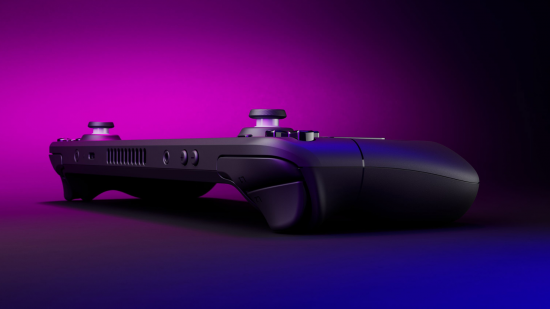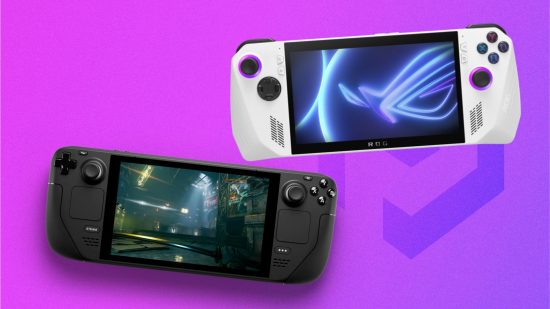As our name suggests, we here at Pocket Tactics live for gaming on the go, and we couldn’t be happier that the latest handheld game consoles offer a wealth and breadth of games to be played, whether you’re traveling or at home sitting on the sofa. But, when it comes down to it, which console wins – we look at the Steam Deck vs Asus ROG Ally to see which we recommend.
If you’re thinking of investing in a new portable gaming console, then we can point you to the best Nintendo Switch console out there at the moment, but you should also consider one of the best gaming phones as the options on the market hold some serious power nowadays.
Let’s get into whether you should go for the Asus ROG Ally vs the Steam Deck.
Asus ROG Ally and Steam Deck specs
Here’s a quick rundown of the key ROG Ally vs Steam Deck specs, so you can get an idea of what makes up each piece of hardware.
| Asus ROG Ally | Steam Deck | |
| APU | AMD Ryzen Z1 Extreme |
AMD Van Gogh |
| Cores/Threads | 8/16 | 4/8 |
| Graphics | 12 RDNA 3 CUs |
8 RDNA 2 CUs |
| RAM | 16GB LPDDR5 6400 MT/s dual channel |
16GB LPDDR5 5500 MT/s quad channel |
| Display | 7-inch IPS 1080p/120Hz VRR |
7-inch IPS 800p/40-60Hz |
| Storage | 512GB PCIe 4.0 SSD / microSD |
64GB – 1TB |
| Weight | 608g |
669g |
| OS | Windows 11 |
SteamOS |
Prices
The Asus ROG Ally retails for $699 (£699) and is available at most large retailers like Best Buy in the US, and Argos or Currys in the UK. There is only one version of the Ally.
The Steam Deck, however, has a few options to choose from with different prices:
- 64GB storage with LCD screen – $349 / £309
- 256GB storage with LCD screen – $399 / £349
- 512GB storage with LCD screen – $449 / £389
- 512GB storage with OLED screen – $549 / £479
- 1TB storage with OLED screen – $649 / £569
Depending on how much storage you want, the price can be a little hefty (but still a good chunk less than the ROG Ally). Different models come in and out of stock, so if the one you want isn’t available, keep checking back.
Features
Let’s cut to the chase. These two handhelds look fairly similar and are around the same size. But what are their differences? If you want a deeper look at either console, we have an ASUS ROG Ally review and a Steam Deck review.
The ROG Ally is significantly more powerful with its AMD Z1 Extreme APU, which you would expect for its higher price. Making use of all that horsepower is a lovely screen, which is faster, sharper, brighter, more vivid, and smoother than the Steam Deck’s.
The refresh rate smooths out the kinks from dropped frames and avoids the hassle of trying to optimize your settings perfectly for a set target. Just set the graphics to your liking and go. And as if the deal wasn’t sweet enough already, Asus is bundling 3 months of Xbox Game Pass for good measure.
However – the Deck absolutely does hold its own and is by no means a slouch. There is more to gaming than raw performance, after all. It also has an advantage in that it has a slightly taller screen. Despite its lower resolution, the screen certainly appears larger despite being a little fuzzier. It also means that framerates can be similar when compared to the ROG Ally due to the lower target resolution.
The Steam Deck has trackpads that enable much more precise control for your 360 no-scopes when paired with the gyro controls. They’re also great for strategy games and navigating the desktop environment. Battery life between the two is comparable, with no clear winner either way. A fast charger is included with the ROG Ally, so your time plugged in will be much less unless you already have a third-party charger for the Deck.
Asus ROG Ally vs Steam Deck design
Both the Asus ROG Ally and Steam Deck are made from plastic. They’re a similar weight, at 608g and 669g respectively, and both have 7-inch screens (however the ROG Ally offers 120Hz over 40-60Hz).
Asus clearly panders to us nerds with the stylish gamer aesthetic of the ROG Ally. We’re not ones to turn our nose up at customizable RGB lighting, and the white design really is something to behold.
The Steam Deck is the more utilitarian of the two. Don’t get us wrong, we’re rather fond of its no-nonsense looks and it holds up really well to the perils faced by a portable machine. If you really can’t stand the look of the Deck, there is an absolute plethora of skins and cases to customize it to your liking.

Ease of use
A slight letdown for the ROG Ally is the smaller grips that make it a little harder to handle, but it is still plenty comfortable, especially with the lighter weight. The asymmetrical joystick layout really stands out here too making it feel a bit more natural in the hand. Using the ROG Ally under a normal gaming load, we found it to be a lot quieter too.
Playing in the Deck’s favor are its supple grips with so much real estate your local council might just build student accommodation on top of it. While functionally great the trackpads do make the joystick layout a little more awkward in our opinion. The Deck is also quite literally loud and proud so you might find yourself having to play less intensive games when amongst company.
Game libraries
Without a doubt, the ROG Ally has a bigger library. This is because it runs Windows 11 rather than the Deck’s Linux-derived SteamOS. Certain games such as Fortnite and Roblox do not play nice with SteamOS, so unless you have the know-how to install Windows on the Deck, you’re outta luck.
A few outliers withstanding though, the Deck can play pretty much any game thrown at it and you can be guaranteed a great experience when choosing games through Valve’s Deck Verified program. It takes a whole lot of the guesswork out and lets you dive straight in. The Deck also benefits from a massive community and emulators that have been tailored to work really well on the Deck’s hardware.

Should you buy the Steam Deck?
If you feel confident upgrading the storage yourself, the 64GB Steam Deck model offers a heck of a lot of performance for a lot less money. The trackpads open up a lot more options for different kinds of games, especially strategy and classic PC titles.
The platform offers endless customizability and has the backing of huge parts and accessories aftermarket to make your Deck truly unique. The cracks are beginning to show, however, and the Deck is struggling to keep up with the latest games. If this is important to you, perhaps your money is better spent on a different portable gaming console.
Should you buy the Asus ROG Ally?
The ROG Ally is expensive and can be harder to recommend if you don’t want the 512GB model of the Deck. You may also find yourself struggling with strategy and older games that don’t play nice with their controllers. If maximum performance is a priority for you then the Ally is likely a better choice. It’s AMD Ryzen Z1 Extreme APU and good specs ensure you’re going to have a smooth, fast, and sharp experience. The Ally also has greater compatibility, including with Xbox’s (PC) Game Pass, so you’re not missing out on any of your favorite games.
Could we perhaps tempt you into trying a handheld with some of the best indie games, or some excellent JRPGs on Switch? If you want to hold out, though, here’s what we know about the Nintendo Switch 2.
